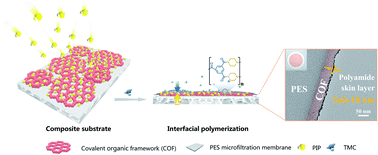当前位置:
X-MOL 学术
›
J. Mater. Chem. A
›
论文详情
Our official English website, www.x-mol.net, welcomes your
feedback! (Note: you will need to create a separate account there.)
Covalent organic framework-modulated interfacial polymerization for ultrathin desalination membranes†
Journal of Materials Chemistry A ( IF 10.7 ) Pub Date : 2019-10-15 , DOI: 10.1039/c9ta08163a Jinqiu Yuan 1, 2, 3, 4, 5 , Mengyuan Wu 1, 2, 3, 4, 5 , Hong Wu 1, 2, 3, 4, 5 , Yanan Liu 1, 2, 3, 4, 5 , Xinda You 1, 2, 3, 4, 5 , Runnan Zhang 1, 2, 3, 4, 5 , Yanlei Su 1, 2, 3, 4, 5 , Hao Yang 1, 2, 3, 4, 5 , Jianliang Shen 1, 2, 3, 4, 5 , Zhongyi Jiang 1, 2, 3, 4, 5
Journal of Materials Chemistry A ( IF 10.7 ) Pub Date : 2019-10-15 , DOI: 10.1039/c9ta08163a Jinqiu Yuan 1, 2, 3, 4, 5 , Mengyuan Wu 1, 2, 3, 4, 5 , Hong Wu 1, 2, 3, 4, 5 , Yanan Liu 1, 2, 3, 4, 5 , Xinda You 1, 2, 3, 4, 5 , Runnan Zhang 1, 2, 3, 4, 5 , Yanlei Su 1, 2, 3, 4, 5 , Hao Yang 1, 2, 3, 4, 5 , Jianliang Shen 1, 2, 3, 4, 5 , Zhongyi Jiang 1, 2, 3, 4, 5
Affiliation

|
The demand for thin-film composite nanofiltration membranes bearing unprecedented water permeance and desirable salt rejection is ever increasing in desalination. Conventional interfacial polymerization usually generates a thick (∼100 nm) skin layer on hydrophobic substrate having low-porosity, leading to limited water permeance. Herein, we engineered a highly porous and superhydrophilic composite substrate to modulate the interfacial polymerization and generate an ultrathin polyamide skin layer, even below 10 nm. The composite substrate was constructed by depositing covalent organic framework nanosheets (CONs) on a microfiltration membrane via vacuum-assistant assembly. Owing to the highly porous structure and superhydrophilic nature of CONs, the composite substrate favored a high storage capacity and uniform distribution of the amine monomers. We manipulated the monomer storage capacity of the substrate by varying the loading content of CONs and demonstrated that higher amino monomer concentration could accelerate the self-sealing and self-termination of the interfacial polymerization, thus generating a thinner skin layer from ∼70 nm to sub-10 nm. Moreover, the highly porous structure of CONs imparted little additional water transport resistance. The sub-10 nm film composite membrane exhibited a superior water permeance of 535.5 L m−2 h−1 MPa−1 with a high rejection of 94.3% for Na2SO4, which was about 2–8 times higher than that of state-of-the-art nanofiltration membranes with comparable rejection.
中文翻译:

用于超薄脱盐膜的共价有机骨架调节的界面聚合†
在海水淡化中,对具有前所未有的透水性和理想的脱盐性的薄膜复合纳米过滤膜的需求在不断增加。常规的界面聚合通常会在具有低孔隙率的疏水性基材上产生一个厚(约100 nm)的表皮层,从而导致有限的水渗透性。本文中,我们设计了一种高度多孔和超亲水性的复合基材,以调节界面聚合并产生甚至低于10 nm的超薄聚酰胺表皮层。复合基板物通过微滤膜上沉积共价有机骨架纳米片(CON外)构成通过真空辅助组件。由于CON的高度多孔结构和超亲水性,复合基材有利于胺单体的高储存能力和均匀分布。我们通过改变CON的负载量来控制底物的单体储存能力,并证明较高的氨基单体浓度可以促进界面聚合反应的自密封和自终止,从而产生从〜70 nm到亚微米级的较薄表皮层。 -10 nm。而且,CONs的高度多孔的结构几乎没有赋予额外的水传输阻力。低于10 nm的薄膜复合膜显示出535.5 L m -2 h -1 MPa -1的优异透水率,对Na 2的排斥率高达94.3%SO 4,比具有可比性的最先进的纳滤膜高约2–8倍。
更新日期:2019-11-13
中文翻译:

用于超薄脱盐膜的共价有机骨架调节的界面聚合†
在海水淡化中,对具有前所未有的透水性和理想的脱盐性的薄膜复合纳米过滤膜的需求在不断增加。常规的界面聚合通常会在具有低孔隙率的疏水性基材上产生一个厚(约100 nm)的表皮层,从而导致有限的水渗透性。本文中,我们设计了一种高度多孔和超亲水性的复合基材,以调节界面聚合并产生甚至低于10 nm的超薄聚酰胺表皮层。复合基板物通过微滤膜上沉积共价有机骨架纳米片(CON外)构成通过真空辅助组件。由于CON的高度多孔结构和超亲水性,复合基材有利于胺单体的高储存能力和均匀分布。我们通过改变CON的负载量来控制底物的单体储存能力,并证明较高的氨基单体浓度可以促进界面聚合反应的自密封和自终止,从而产生从〜70 nm到亚微米级的较薄表皮层。 -10 nm。而且,CONs的高度多孔的结构几乎没有赋予额外的水传输阻力。低于10 nm的薄膜复合膜显示出535.5 L m -2 h -1 MPa -1的优异透水率,对Na 2的排斥率高达94.3%SO 4,比具有可比性的最先进的纳滤膜高约2–8倍。















































 京公网安备 11010802027423号
京公网安备 11010802027423号